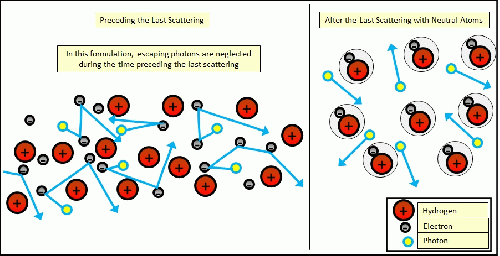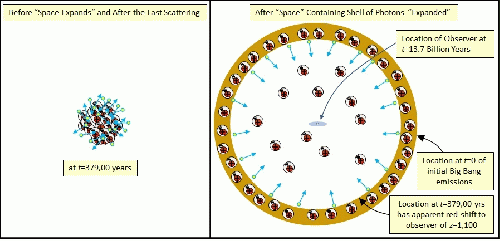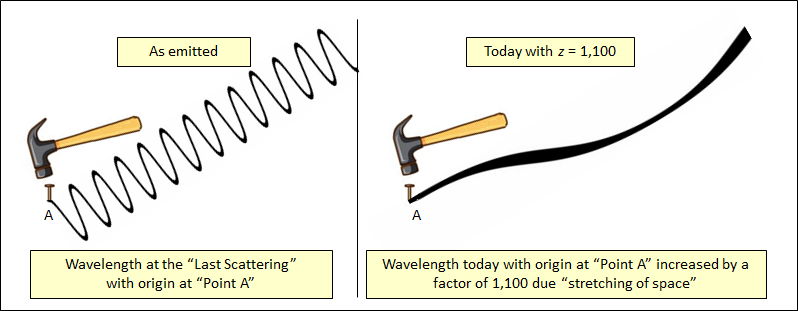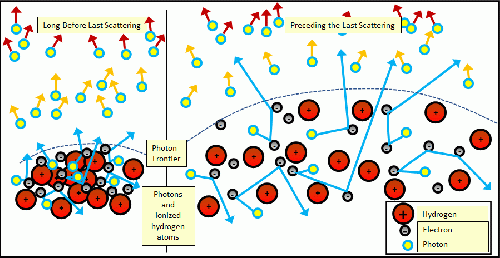Cosmic Microwave Background (CMB)
The widespread conceptualization of the origin of the CMB phenomenon is shown in Figure 1. Based on well-known physical processes related to plasmas - gas clouds are opaque to the passage of photons when temperatures are above 3,000 degrees Kelvin because photons cannot avoid being reflected by ionized atomic particles. In this manner, it has been assumed that photons and radiated energy were trapped in a hot, opaque, ionized fog as shown on the left side of Figure 1. As the Universe cooled, the hydrogen nuclei and electrons coalesced into neutral atoms during the process known as recombination or, the "last scattering", as shown on the right side of the Figure 1.

Figure 1: The standard explanation for the origin of the Cosmic Microwave Background is that, upon recombination, photons were no longer scattered by ionized matter and the Universe became transparent allowing photons to travel unimpeded.
(Image by Wayne H. Coste, BS-EE, PE, IEEE-SM) Details DMCA
Recombination allowed the photons to travel relatively unimpeded out into the Universe as the hot, ionized fog became transparent. Consequently, the photons traveled in the direction that they were heading at the moment the Universe became transparent. The left side of Figure 2 (which is equivalent to the right side of Figure 1) shows a zoomed-out version of the last scattering with neutral atoms. The photons are shown mostly traveling internally through the newly transparent sea of particles. In actuality, the photons would be traveling in all possible directions. On the right side of Figure 2, the sea of particles is shown as just a ring with the observer (and supposedly the rest of the observable Universe) somewhere in the interior. In textbook explanations, the ring was formed by space expanding so quickly via "cosmic inflation" that the photons of the last scattering are still heading toward the observer who would be, apparently, somewhere in the midst of that sea of particles. For illustration purposes the observer is assumed to be on the Earth and located in the Milky Way and near the center of the sphere.

Figure 2: Textbook explanations of the CMB say that at 379.000 years following the Big Bang the photons could pass through neutral atoms. Once space expanded, the photons continued toward our instruments, but with their wavelengths stretched by a factor o
(Image by Wayne H. Coste, BS-EE, PE, IEEE-SM) Details DMCA
Under this hypothesis, the CMB is an artifact of the effect that was estimated to have occurred approximately 379,000 years after the Big-Bang. Under this construct, these primordial fossil photons have been traveling toward earth for 13.7 billion years and those that have reached us have finally covered the initial separation distance of 0.0004 to 0.0008 billion light years. These tiny fractions of a billon years are based on the assumed radius of the Universe at the time of the last scattering and the maximum distance between any two points at that time. It is assumed that the hot ionized fog would have been that size - at give-or-take a few orders of magnitude. It is widely explained that the reason the radiated energy took so many billions of years to travel such a relatively "short" distance was because space was expanding at a high fraction of the speed of light. In other words, the electromagnetic waves that are being observed by our instruments today are the waves that were directed inward into what is now the observable Universe from the distant ring shown on right side of Figure 2.
The right side of Figure 2 shows neutral atoms in the outer shell in addition to the photons of the last scattering. If space is what was expanding, all of the particles in that portion of space would have expanded alongside the photons also, due to their simultaneous genesis and co-location in the Big Bang singularity just a "short time" before. Additionally, assuming that the hot, ionized cloud of particles was homogeneous and isotropic the "expansion of space" to create the CMB sphere would mean that the particles that would form the Milky Way galaxy would have been somewhere in the interior of that sea of particles. Additionally, that would mean there would be a continuum of particles and photons all the way out to the CMB with red-shifts of the wavelengths increasing from z=0 up to z=1,100. Under this explanation, the CMB radiation should have counter parts at all other distances to the observer. Such a continuous effect would make the spectrum from the CMB unremarkable due to all the other similar layers toward the interior.
The left side of Figure 3 shows the conceptual example where the emitted radiated energy from the last scattering (see position "A") had a specific wavelength when the plasma temperature had cooled to the range of 3,000 degrees Kelvin. Under the prevailing theories, the wavelength was stretched through the expansion of space alone as shown on the right side of Figure 3.

Figure 3: When electro-magnetic waves are emitted, they have a characteristic wavelength based on its energy. Under the prevailing CMB explanation, the wavelength of the CMB radiation was stretched as space, itself, expanded.
(Image by Wayne H. Coste, BS-EE, PE, IEEE-SM) Details DMCA
Because of this observed continuous connection with the photons of the CMB, the prevailing explanation suggests that we should be able to sense the presence of primordial galaxies with red shifts out to z=1,100. Under this construct, all radiation-emitting objects within the Universe should have a light path connecting each source and our instruments to, at least, the microwave range.
However, the most distant galaxies that have been observed are on the order of 10 while the redshift for the cosmic background radiation is two orders of magnitude higher, at about 1,100.
GRSGM and the CMB
An alternative explanation for the source of the CMB may be hypothesized as the radiation originating with the Big-Bang including the time before recombination (e.g., the last scattering) and continuing up to the present. Figure 4 shows a revised characterization of the physics during the time before recombination in which a significant amount of the energy was radiated outward at very high energies. This emission of radiation at very high energies was most intense in the immediate aftermath of the Big Bang and would have created a continuous stream of photons that escaped outward from the leading edge of the expanding hot ionized fog. Photons escaping from the leading edge would not be affected by whether the ionized fog behind was opaque or not.

Figure 4: For the entire time before the Last Scattering, photons have been emitted outside the expansion of the fermions comprising the primordial protons and electrons. Note that the electrons are continually scattered in off-radial directions
(Image by Wayne H. Coste, BS-EE, PE, IEEE-SM) Details DMCA
However, consistent with the dynamics prior to recombination, the direction of the photons would not only be radial, but could also be nearly parallel to the photon frontier. The off-radial photon trajectories prior to recombination could be a source of transverse photons that would then cause interference and also create impacts with other photons within the streams of outgoing radiation and thus they would have an effect on the outgoing radiation which could lead to the formation of what we now call the CMB.
During the primordial nucleosynthesis, high energy photon-photon collisions were responsible for the creation of particle-antiparticle pairs. While the post-recombination transverse photons would have much less energy, they would be expected to interact with other photons at some level including collisions.
(Note: You can view every article as one long page if you sign up as an Advocate Member, or higher).




